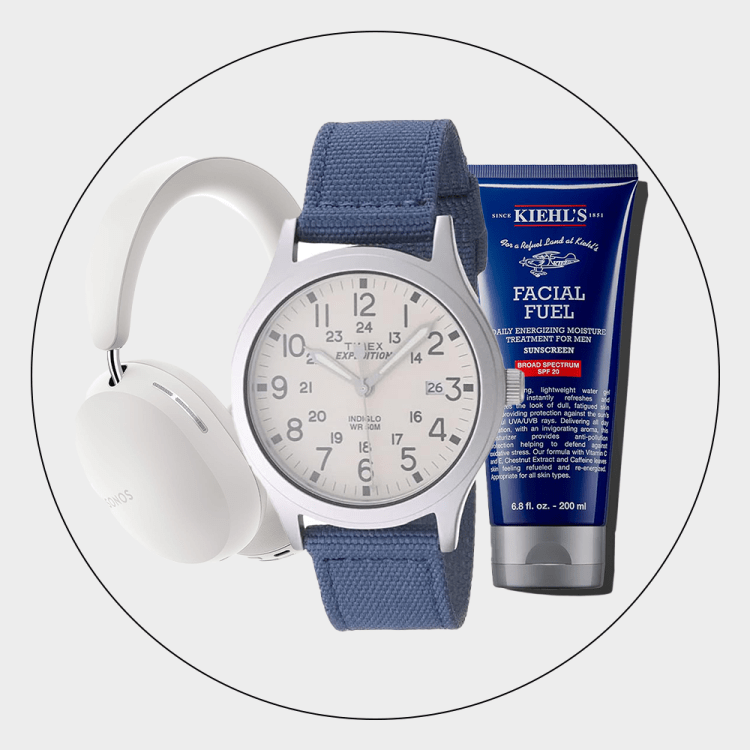I’ve spilled coffee on myself on two commutes in the last two weeks. I’m about to turn 30 — what the hell is wrong with me? Maybe I’m filling the Yeti a little too aggressively. Maybe the drink holsters on my backpack (which is about to turn five) are starting to give way. Maybe I need to stop hauling ass up the subway stairs.
At any rate, I’ve resolved to start walking with my tumbler firmly in my grasp. It keeps my phone away, a nice mini digital detox, and constitutes a not-nothing exercise for the 34 little muscles in my hand. And lately, realizing my right hand was doing all the work, I’ve made a point to shift the coffee over to my left hand.
The 51 Best Father’s Day Gifts for Every Dad
Gifts for every type of father imaginableIt would be misleading to call this “hard” — it’s a 30-ounce bottle, not a 30-pound dumbbell. But my left hand is non-dominant; I don’t use it to eat, brush my teeth, twist doorknobs or pick things up off the floor. I certainly don’t use it while dribbling, as those who’ve been lucky enough to guard me on the basketball court know well.
My little morning exercise got me thinking: should I be engaging with my non-dominant hand more often? Are there any benefits to this sort of training? Not just physically — could a casual flirtation with ambidexterity be good for the brain?
What Science Says About Switching Hands
In 2021, a team of Japanese researchers entered a group of healthy, right-handed adults into a chopstick training program. For six weeks, the volunteers could only use chopsticks with their left hands. The experiment proved fruitful, improving “non-dominant chopstick operation skills” across the board and leading “to the acquisition of skill levels similar to those of the dominant hand.”
Beyond being a useful party trick, the findings had tangible implications for stroke patients, who sometimes have to change their “handedness” due to paralysis. Within this context, the researchers referred to exercising one’s non-dominant hand as “tool-use training.” With practice, it’s possible to develop a fine motor skill, even at advanced age.
The study’s authors also monitored brain activity, and detected changes in cortexes associated with planning and coordination, suggesting the brain can “reorganize” itself internally to support the challenge of training one’s weaker hand.
The Charge by InsideHook
A wellness newsletter to help you move better, think clearer and stay in the game longer. One email every Monday — we’re building habits, not chasing hacks.
Other studies have reached similar conclusions. In a University of Missouri study, adults underwent “chronic forced” precision drawing with their non-dominant left hands. A whopping 89% of participants demonstrated increased “hand speed, accuracy and smoothness” — and their brains showed it.
Researchers expected more “cross-talk” between hemispheres (you may have seen people online claim that switching hands helps “activate the other side of your brain”). But brain scans revealed that both hand-control areas were working more closely with a region in the dominant hemisphere known for planning and executing skilled movements. So the gains in precision came from the brain leaning on smarter, more efficient motor pathways it already had in place.
In other words, improving your non-dominant hand isn’t about rewiring your brain from scratch — it’s about waking up systems that were always there, just waiting to be used.
Should You “Train” Your Non-Dominant Hand?
Obviously using a non-dominant hand can be stressful on your mind and muscles — even if you’re just clutching a coffee cup. That sort of unnecessary stress might make the effort a little too annoying to stick to over a period of time. Why brush my teeth with my left hand if I need to be out of the house in the next three minutes?
The benefits of modest, targeted training are most likely to be felt long-term. For instance, if you commit to unloading a dishwasher with your non-dominant hand each morning, you might get in the habit of engaging flexible brain systems and boosting manual dexterity. It’s possible the practice could have transferable gains, making it easier to perform other complex motor tasks with less effort down the line. Think tasks in sports, music or cooking.
On the other hand (sorry), optimizing your non-dominant hand will not boost your IQ, memory or creativity — despite the fluff you may hear in an Instagram Reel.
If there’s any instant gratification from this sort of training, it’s in the focus it compels. Employing your non-dominant hand is an act of mindful self-regulation, a sort of mini mental obstacle course. For me, on those morning commutes, it just makes me more aware of my body moving through space — which, even with my weak hand involved, ironically, makes me less likely to spill caffeine on cotton.
Whether you’re looking to get into shape, or just get out of a funk, The Charge has got you covered. Sign up for our new wellness newsletter today.





















